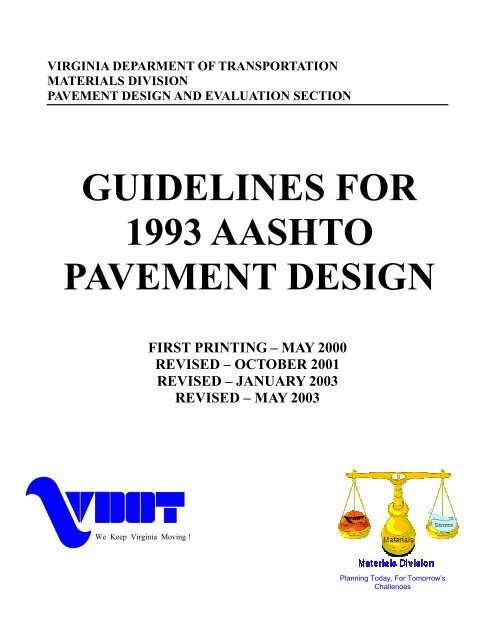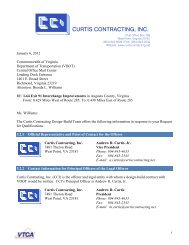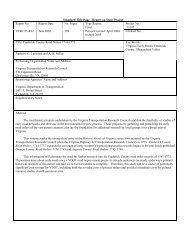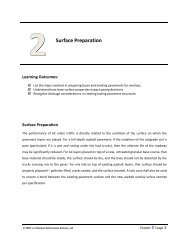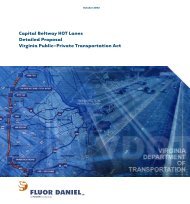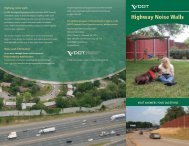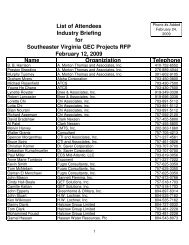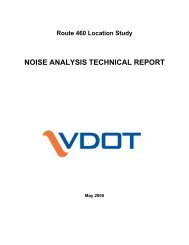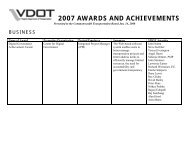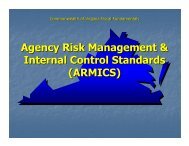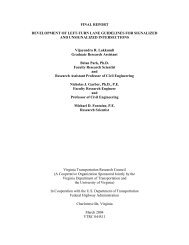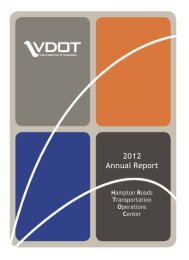Pavement Design Guidelines - Virginia Department of Transportation
Pavement Design Guidelines - Virginia Department of Transportation
Pavement Design Guidelines - Virginia Department of Transportation
You also want an ePaper? Increase the reach of your titles
YUMPU automatically turns print PDFs into web optimized ePapers that Google loves.
<strong>Guidelines</strong> For 1993 AASHTO <strong>Pavement</strong> <strong>Design</strong> May 2003<strong>Pavement</strong> <strong>Design</strong> and Evaluation SectionTable <strong>of</strong> ContentsI. FLEXIBLE PAVEMENT DESIGN..................................................................................... 1<strong>Design</strong> Variables ......................................................................................................................... 1<strong>Pavement</strong> <strong>Design</strong> Life ............................................................................................................. 1Traffic Factors ......................................................................................................................... 1Reliability ................................................................................................................................ 2Serviceability........................................................................................................................... 2Standard Deviation .................................................................................................................. 3Stage Construction................................................................................................................... 3Material Information ................................................................................................................... 3Structural Layer Coefficients (New <strong>Design</strong> and Overlay) ...................................................... 3AC Material Layer Thickness ................................................................................................. 3Drainage Coefficients (m) .......................................................................................................3<strong>Design</strong> Subgrade Resilient Modulus ....................................................................................... 3Shoulder <strong>Design</strong> ...................................................................................................................... 4<strong>Pavement</strong> Drainage Considerations......................................................................................... 5II. RIGID PAVEMENT DESIGN......................................................................................... 6<strong>Design</strong> Variables ......................................................................................................................... 6<strong>Pavement</strong> <strong>Design</strong> Life ............................................................................................................. 6Traffic Factors ......................................................................................................................... 6Reliability ................................................................................................................................ 7Serviceability........................................................................................................................... 7Material Information ................................................................................................................... 828-Day Mean PCC Modulus <strong>of</strong> Rupture (psi)......................................................................... 828-Day Mean PCC Modulus <strong>of</strong> Elasticity (psi)....................................................................... 8Mean Effective k-value (psi/inch) ........................................................................................... 8Subdrainage Coefficient .......................................................................................................... 8Load Transfer Factors.............................................................................................................. 9Shoulder <strong>Design</strong> ...................................................................................................................... 9<strong>Pavement</strong> Drainage Considerations....................................................................................... 10
<strong>Guidelines</strong> For 1993 AASHTO <strong>Pavement</strong> <strong>Design</strong> May 2003<strong>Pavement</strong> <strong>Design</strong> and Evaluation Section Page 1FLEXIBLE PAVEMENT DESIGN<strong>Design</strong> Variables<strong>Pavement</strong> <strong>Design</strong> LifeHighway ClassificationInitial Construction<strong>Design</strong> (Years)Interstate 30 12Divided Primary Route 30 12Undivided Primary Route 20 10High Volume Secondary Route 20 10Farm to Market Secondary Route 20 10Residential/Subdivision Street 20 10Traffic FactorsInitial Overlay<strong>Design</strong> (Years)Lane Distribution FactorsNumber <strong>of</strong> Lanes Per Direction VDOT Value for <strong>Pavement</strong> <strong>Design</strong> (%)1 1002 903 704 or more 60Traffic Growth Rate CalculationGR = [((ADT f / ADT i ) (1/(F-I)) )-1] x 100Where:GR = Growth Rate (%)ADT f = Average daily traffic for future yearADT i = Average daily traffic for initial yearI = Initial year for ADTF = Future year for ADTFuture ADT CalculationIf an ADT and growth rate is provided, then a future ADT can be calculated using the followingequation:ADT f = ADT I (1+GR) (F-I)
<strong>Guidelines</strong> For 1993 AASHTO <strong>Pavement</strong> <strong>Design</strong> May 2003<strong>Pavement</strong> <strong>Design</strong> and Evaluation Section Page 2Where:GR = Growth Rate (%)ADT f = Average daily traffic for future yearADT i = Average daily traffic for initial year (year traffic data is provided)I = Initial year for ADTF = Future year for ADTESAL FactorsWhen no Weigh in Motion (WIM) or vehicle classification data are available to determine actualEquivalent Single Axle Loads (ESAL) Factors, use the following values:Vehicle Classification ESAL FactorCars/Passenger Vehicles 0.0002Single Unit Trucks 0.37Tractor Trailer Trucks 1.28If traffic classification or WIM data are available, use Appendix D <strong>of</strong> the 1993 AASHTO <strong>Design</strong>Guide for <strong>Pavement</strong> Structures to determine ESAL factors.ESAL CalculationFor the ESAL Calculation, use Compound Growth Factors. Assume Truck Growth ESAL Factoris 0%.ReliabilityVDOT Value for <strong>Pavement</strong> <strong>Design</strong>Highway Classification Urban RuralInterstate 95 95Divided Primary Route 90 90Undivided Primary Route 90 85High Volume Secondary Route 90 85Farm to Market Secondary Route 85 75Residential/Subdivision Street 75 70ServiceabilityVDOT Value for <strong>Pavement</strong> <strong>Design</strong>Highway Classification Initial TerminalInterstate 4.2 3.0Divided Primary Route 4.2 2.9Undivided Primary Route 4.2 2.8High Volume Secondary Route 4.2 2.8Farm to Market Secondary Route 4.0 2.5Residential/Subdivision Street 4.0 2.0
<strong>Guidelines</strong> For 1993 AASHTO <strong>Pavement</strong> <strong>Design</strong> May 2003<strong>Pavement</strong> <strong>Design</strong> and Evaluation Section Page 3Standard DeviationFor flexible pavements, the standard deviation <strong>of</strong> 0.49 shall be used.Stage ConstructionThis is an option in the Darwin pavement design program, select Stage 1 construction.Material InformationStructural Layer Coefficients (New <strong>Design</strong> and Overlay)Material VDOT Value for <strong>Pavement</strong> <strong>Design</strong> (a i )SM-9.0 .44SM-9.5 .44SM-12.5 .44IM-19.0 .44BM-25.0 .40BM-37.5 .37SMA 9.5, SMA 12.5, SMA 19.0 .44Graded Aggregate Base – 21A or 21B .12Cement Treated Aggregate Base .20Rubblized Concrete .18Break and Seat/Crack and Seat .25Soil Cement .18Lime Treated Soil .18Gravel .10Open Graded Drainage Layer – Bound .10Open Graded Drainage Layer – Unbound 0 – .10All other soilsNo Layer CoefficientAC Material Layer ThicknessMaterial Minimum Lift Thickness (in.) Maximum Lift Thickness (in.)SM-9.0 0.75 1.25SM-9.5 1.25 1.5SMA 9.5 1.25 1.5SM-12.5 1.5 2SMA 12.5 1.5 2SMA 19.0 2 3IM-19.0 2 3BM-25.0 2.5 4BM-37.5 3 6Drainage Coefficients (m)For most designs, use a value <strong>of</strong> 1.0. If the quality <strong>of</strong> drainage is known as well as the period <strong>of</strong>time the pavement is exposed to levels approaching saturation, then refer to Table 2.4 in the 1993AASHTO Guide for the <strong>Design</strong> <strong>of</strong> <strong>Pavement</strong> Structures.<strong>Design</strong> Subgrade Resilient ModulusCaution must be used when selecting a design resilient modulus. An analysis <strong>of</strong> all the soils datashould be conducted prior to selecting a value. An average Resilient Modulus (Mr) should not be
<strong>Guidelines</strong> For 1993 AASHTO <strong>Pavement</strong> <strong>Design</strong> May 2003<strong>Pavement</strong> <strong>Design</strong> and Evaluation Section Page 4used as the design Mr if the coefficient <strong>of</strong> variance (Cv) is greater than 10%. If the Cv is greaterthan 10%, then the <strong>Pavement</strong> <strong>Design</strong>er should look at sections with similar Mr values and designthose section based on that average Mr. If no sections clearly exist, then use the average Mrtimes 67% to obtain the design Mr. For those locations with an actual Mr less than the designMr, then the pavement designer should consider a separate design for that location orundercutting the area.If resilient modulus results are not available, then use the following correlations:For fine-grained soils with a soaked CBR between 5 and 10 , use the following equation tocorrelate CBR to resilient modulus (Mr):<strong>Design</strong> Mr (psi) = 1,500 x CBRFor non fine-grained soils with a soaked CBR greater than 10, use the following equation:Mr = 3,000 x CBR 0.65Typical values for fine-grained soils are 2,000 to 10,000 psi.Typical values for course-grained soils are 10,000 to 20,000 psi.When FWD testing is conducted and the backcalculated resilient modulus is determined, use thefollowing equation:Where C = 0.33<strong>Design</strong> Mr = C x Backcalculated MrIf CBR and backcalculated Mr results are available, use the smaller <strong>Design</strong> Mr for pavementdesign purposes.If the <strong>Design</strong> Mr based on CBR is greater than 15,000 psi or if the <strong>Design</strong> Mr frombackcalculation is greater than 15,000 psi, then use a <strong>Design</strong> Mr value <strong>of</strong> 15,000 psi.Shoulder <strong>Design</strong>Typically, paved shoulders have a pavement structural capacity less than the mainline; however,this is dependent on the roadway. For Interstate routes, the pavement shoulder shall have thesame design as the mainline pavement. This will allow the shoulder to support extended periods<strong>of</strong> traffic loading as well as provide additional support to the mainline structure. A full-depthshoulder (same design as the mainline pavement) is also recommended for other high-volumenon-interstate routes.Where a full-depth shoulder is not necessary, the shoulder’s pavement structure should be basedon 2.5% <strong>of</strong> the design ESALs (minimum) for the project following the AASHTO pavementdesign methodology. A minimum <strong>of</strong> two AC layers must be designed for the shoulder in order toprovide edge support for the mainline pavement structure. The AC layers must be placed on anaggregate or cement stabilized aggregate layer, not directly on subgrade, to provide adequatesupport and drainage for the shoulder structure. To help ensure positive subsurface drainage, thetotal pavement depth <strong>of</strong> the shoulder should be equal to the mainline structure (i.e. mainlinepavement structure thickness above the subgrade is 20 inches, shoulder pavement structurethickness above the subgrade is 20 inches).
<strong>Guidelines</strong> For 1993 AASHTO <strong>Pavement</strong> <strong>Design</strong> May 2003<strong>Pavement</strong> <strong>Design</strong> and Evaluation Section Page 5<strong>Pavement</strong> Drainage ConsiderationsThe presence <strong>of</strong> water within the pavement structure has a detrimental effect on the pavementperformance under anticipated traffic loads. The following are guidelines to minimize theseeffects:1. Standard UD-2 underdrains and outlets are required on all raised medians to preventwater infiltration through or under the pavement structure. Refer to the current VDOTRoad and Bridge Standards for installation details.2. When Aggregate Base Material, Type I, Size #21-B is used as an untreated base orsubbase, it should be connect to a longitudinal pavement drain (UD-4) with outlets ordaylighted (to the face <strong>of</strong> the ditch) to provide for positive lateral drainage on allroadways with a design ADT <strong>of</strong> 1,000 vehicles per day or greater. (Refer to the currentVDOT Road and Bridge Standards for installation details.) Other drainage layers canalso be used. When the design ADT is less than a 1,000 vehicles per day, the Engineermust assess the potential for the presence <strong>of</strong> water and determine if sub-surface drainageprovisions should be made.3. Undercutting, transverse drains, stabilization, and special design surface and subsurfacedrainage installations should be considered whenever necessary to minimize the adverseimpacts <strong>of</strong> subsurface water on the stability and strength <strong>of</strong> the pavement structure.4. Standard CD-1 and CD-2 should be considered for use with all types <strong>of</strong> unstablizedaggregates, independent <strong>of</strong> the traffic levels.5. For roadways with a design ADT <strong>of</strong> 20,000 vehicles per day or greater, a drainage layershould be used, placed on not less than 6 inches <strong>of</strong> stabilized material and connected to aUD-4 edge drain.For additional information see Report Number FHWA-TS-80-224, Highway Sub-Drainage<strong>Design</strong> from the US <strong>Department</strong> <strong>of</strong> <strong>Transportation</strong>, Federal Highway Administration.
<strong>Guidelines</strong> For 1993 AASHTO <strong>Pavement</strong> <strong>Design</strong> May 2003<strong>Pavement</strong> <strong>Design</strong> and Evaluation Section Page 6RIGID PAVEMENT DESIGN<strong>Design</strong> Variables<strong>Pavement</strong> <strong>Design</strong> LifeHighway ClassificationInitialConstruction<strong>Design</strong> (Years)Initial ACOverlay <strong>Design</strong>(Years)Initial PCC Overlay<strong>Design</strong>(Years)Interstate 30 10 30Divided Primary Route 30 10 30Undivided Primary Route 30 10 30High Volume Secondary Route 30 10 30Traffic FactorsLane Distribution FactorsNumber <strong>of</strong> Lanes Per Direction VDOT Value for <strong>Pavement</strong> <strong>Design</strong> (%)1 1002 903 704 or more 60Traffic Growth Rate CalculationGR = [((ADT f / ADT i ) (1/(F-I)) )-1] x 100Where:GR = Growth Rate (%)ADT f = Average daily traffic for future yearADT i = Average daily traffic for initial yearI = Initial year for ADTF = Future year for ADTFuture ADT CalculationIf an ADT and growth rate is provided, then a future ADT can be calculated using the followingequation:ADT f = ADT I (1+GR) (F-I)
<strong>Guidelines</strong> For 1993 AASHTO <strong>Pavement</strong> <strong>Design</strong> May 2003<strong>Pavement</strong> <strong>Design</strong> and Evaluation Section Page 7Where:GR = Growth Rate (%)ADT f = Average daily traffic for future yearADT i = Average daily traffic for initial year (year traffic data is provided)I = Initial year for ADTF = Future year for ADTESAL FactorsWhen no Weigh in Motion (WIM) or vehicle classification data are available to determine actualEquivalent Single Axle Loads (ESAL) Factors, use the following values:Vehicle Classification ESAL FactorCars/Passenger Vehicles 0.0003Single Unit Trucks 0.56Tractor Trailer Trucks 1.92ESAL CalculationFor the ESAL Calculation, use Compound Growth Factors. Assume Truck Growth ESAL Factoris 0%.ReliabilityVDOT Value for <strong>Pavement</strong> <strong>Design</strong> (%)Highway Classification Urban RuralInterstate 95 95Divided Primary Route 90 90Undivided Primary Route 90 85High Volume Secondary Route 90 85ServiceabilityVDOT Value for <strong>Pavement</strong> <strong>Design</strong>Highway Classification Initial TerminalInterstate 4.5 3.0Divided Primary Route 4.5 2.9Undivided Primary Route 4.5 2.8High Volume Secondary Route 4.5 2.8Standard DeviationFor rigid pavements, the standard deviation <strong>of</strong> 0.39 shall be used.
<strong>Guidelines</strong> For 1993 AASHTO <strong>Pavement</strong> <strong>Design</strong> May 2003<strong>Pavement</strong> <strong>Design</strong> and Evaluation Section Page 8Material Information28-Day Mean PCC Modulus <strong>of</strong> Rupture (psi)Typical Range – 600 to 800 VDOT Value for <strong>Pavement</strong> <strong>Design</strong> – 650Use default value if actual value is not available. Where possible, use value base on historicaldata.28-Day Mean PCC Modulus <strong>of</strong> Elasticity (psi)Typical Range – 3,000,000 to 8,000,000 VDOT Value for <strong>Pavement</strong> <strong>Design</strong> – 5,000,000Use default value if actual value is not available. Where possible, use value base on historicaldata.Mean Effective k-value (psi/inch)Typical Range – 50 to 500 VDOT Value for <strong>Pavement</strong> <strong>Design</strong> – 250If the subgrade resilient modulus is known or obtained from the CBR, then use the followingequation:k-value = Mr / 19.4Caution must be used when selecting a design k-value based on resilient modulus and CBR. Ananalysis <strong>of</strong> all the soils data should be conducted prior to selecting a value. An average ResilientModulus (Mr) should not be used as the design Mr if the coefficient <strong>of</strong> variance (Cv) is greaterthan 10%. If the Cv is greater than 10%, then the <strong>Pavement</strong> <strong>Design</strong>er should look at sections withsimilar Mr values and design those section based on that average Mr. If no sections clearly exist,then use the average Mr times 67% to obtain the design Mr. For those locations with an actualMr less than the design Mr, then the pavement designer should consider a separate design for thatlocation or undercutting the area.If the k-value is obtained from backcalculation, then use this value.If k-value (based on backcalculation or subgrade resilient modulus) is larger than 500, then use500 as the design value.Subdrainage CoefficientUse a value <strong>of</strong> 1.0 for design purposes.
<strong>Guidelines</strong> For 1993 AASHTO <strong>Pavement</strong> <strong>Design</strong> May 2003<strong>Pavement</strong> <strong>Design</strong> and Evaluation Section Page 9Load Transfer FactorsNew <strong>Pavement</strong> <strong>Design</strong>s and Unbonded PCC Overlays with Load Transfer DevicesVDOT Value for <strong>Design</strong><strong>Pavement</strong> Type Asphalt Shoulder Tied PCC Shoulder or WideLaneJointed Plain 3.2 2.8Jointed Reinforced 3.2 2.8ContinuouslyReinforced3.0 2.6Overlays <strong>Design</strong>s on Existing <strong>Pavement</strong>sFor AC overlays on existing PCC pavements and bonded PCC overlays, determine theappropriate J-Factor based on the load transfer efficiency determined from joint/crack testing.<strong>Pavement</strong> Type Load Transfer Efficiency VDOT <strong>Design</strong> J-FactorJointed Plain > 70% 3.250 – 70% 3.5< 50% 4.0Jointed Reinforced > 70% 3.250 – 70% 3.5< 50% 4.0Continuously Reinforced2.4 (working cracks repairedwith CRCP)Shoulder <strong>Design</strong>Two types <strong>of</strong> shoulders are designed for Portland cement concrete highways – full-width concreteshoulders, narrow-width concrete section with an asphalt concrete extension, or an asphaltshoulder. For full-width concrete shoulders, the pavement shoulder shall have the same design asthe mainline pavement. This will allow the shoulder to support extended periods <strong>of</strong> trafficloading as well as provide additional support to the mainline structure.A narrow-width concrete section with an asphalt concrete extension shoulder is constructed whena wide concrete lane (14 feet) is part <strong>of</strong> the mainline pavement. Twelve feet <strong>of</strong> the fourteen-footwide slab is part <strong>of</strong> the outside travel lane, the remaining two feet is striped and designated as part<strong>of</strong> the shoulder. The two-foot section <strong>of</strong> concrete has the same structure as the twelve-footsection; therefore, no separate pavement design is necessary. For the asphalt concrete portion <strong>of</strong>the shoulder and other asphalt concrete shoulders, the shoulder’s pavement structure should bebased on 2.5% <strong>of</strong> the design ESALs (minimum) for the project following the AASHTO pavementdesign methodology. A minimum <strong>of</strong> two AC layers must be designed for the shoulder. The AClayers must be placed on an aggregate or cement stabilized aggregate layer, not directly onsubgrade, to provide adequate support and drainage for the shoulder structure. To help ensurepositive subsurface drainage, the total pavement depth <strong>of</strong> the shoulder should be equal to themainline structure (i.e. mainline pavement structure thickness above the subgrade is 20 inches,shoulder pavement structure thickness above the subgrade is 20 inches).
<strong>Guidelines</strong> For 1993 AASHTO <strong>Pavement</strong> <strong>Design</strong> May 2003<strong>Pavement</strong> <strong>Design</strong> and Evaluation Section Page 10<strong>Pavement</strong> Drainage ConsiderationsThe presence <strong>of</strong> water within the pavement structure has a detrimental effect on the pavementperformance under anticipated traffic loads. The following are guidelines to minimize theseeffects:1. Standard UD-2 underdrains and outlets are required on all raised medians to preventwater infiltration through or under the pavement structure. Refer to the current VDOTRoad and Bridge Standards for installation details.2. When Aggregate Base Material, Type I, Size #21-B is used as an untreated base orsubbase, it should be connect to a longitudinal pavement drain (UD-4) with outlets ordaylighted (to the face <strong>of</strong> the ditch) to provide for positive lateral drainage on allroadways with a design ADT <strong>of</strong> 1,000 vehicles per day or greater. (Refer to the currentVDOT Road and Bridge Standards for installation details.) Other drainage layers canalso be used. When the design ADT is less than a 1,000 vehicles per day, the Engineermust assess the potential for the presence <strong>of</strong> water and determine if sub-surface drainageprovisions should be made.3. Undercutting, transverse drains, stabilization, and special design surface and subsurfacedrainage installations should be considered whenever necessary to minimize the adverseimpacts <strong>of</strong> subsurface water on the stability and strength <strong>of</strong> the pavement structure.4. Standard CD-1 and CD-2 should be considered for use with all types <strong>of</strong> unstablizedaggregates, independent <strong>of</strong> the traffic levels.5. For roadways with a design ADT <strong>of</strong> 20,000 vehicles per day or greater, a drainage layershould be used, placed on not less than 6 inches <strong>of</strong> stabilized material and connected to aUD-4 edge drain.For additional information see Report Number FHWA-TS-80-224, Highway Sub-Drainage<strong>Design</strong> from the US <strong>Department</strong> <strong>of</strong> <strong>Transportation</strong>, Federal Highway Administration.


